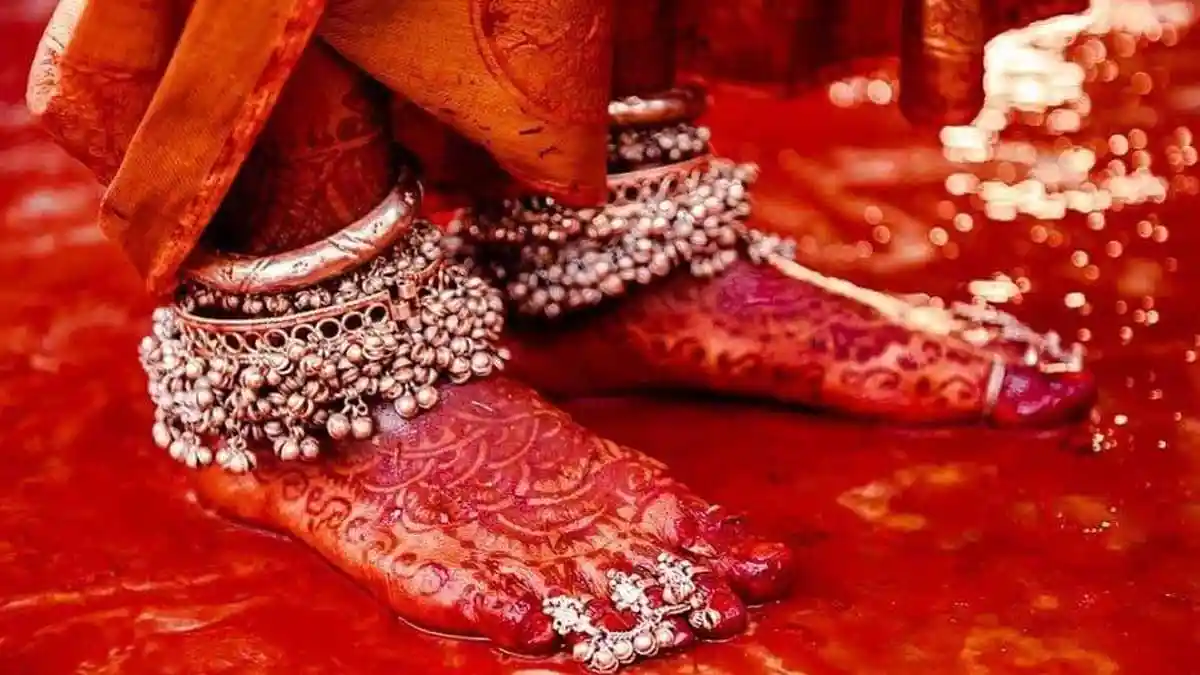Bicchiya: The Secret Language of Toe Rings - Insights into History and Science
Toe rings are not just jewellery for Indian women. Ornaments like toe rings hold special significance and are exclusively worn by married women and have scientific and historical roots. This story sheds light on the intriguing connection between women's rituals and their potential scientific explanations.

Indian married women wear toe rings or bicchiya as a symbol of their marital status. Image Courtesy: Pinterest
Within the rich fabric of Indian culture, the custom of adorning one's feet with toe rings, referred to as "Bichiya" in Hindi, "Mettelu" in Telugu, "Metti" in Tamil, and "Kalungura" in Kannada, holds a position of utmost significance and reverence. This cherished tradition, deeply rooted in history, is steeped in profound symbolism, and is meticulously observed by married Hindu women across the land. The resplendent toe ring also referred to as "bichwa," serves as an unequivocal emblem of their matrimonial status. However, it is important to note that these adornments are not crafted from gold, for gold, is revered as a metal of esteemed regard, and is deemed too precious to be worn below the waistline. Such is the reverence Hindus hold for gold, believing it to be the sacred medium of the Gods, a symbol of Lakshmi, the benevolent Goddess of Wealth. Consequently, it is considered unseemly to bestow this divine metal upon the lower regions of the body.
Traditionally, a large ring was worn on the left great toe as a symbol of marriage. Toe rings held immense significance as indicators of a married woman's status. In Hindu culture, unmarried girls are prohibited from wearing these rings, a practice that continues even today. The act of wearing toe rings carries a deeper meaning, symbolizing a woman's dual role as both sister and wife. As a representation of this duality, women wear two sets of toe rings on each foot—one set for their brother and another for their husband. Should either the husband or brother pass away, one set of rings is removed. This symbolizes that if the husband were to pass, the brother assumes the responsibility of offering protection and support to his sister.
History:
The significance of toe rings can be traced back to the great Indian epic, the Ramayana. In this epic tale, when Sita was abducted by Ravana, she cleverly dropped her toe ring (kaniazhi) along the way as a means of identification for Lord Rama. This incident exemplifies the usage of toe rings since ancient times.
The concept of sixteen Shringaar, which encompasses sixteen traditional embellishments for women, was established during the Vedic era. As part of this tradition, even during the Navdurga Puja, the mother deity is adorned with toe rings, highlighting their integral role in a bride's "solah shringar" or sixteen adornments. In some instances, men would wear a ring on their big toe for therapeutic purposes or to enhance their masculine vigour. Scene

A scene from the epic Ramayan, where Ravan throws Sita’s toe rings, but this later becomes a path for Rama to come and help and rescue Sita. Image Courtesy: Pinterest.
Scientific and Ayurvedic reasons:
The silver toe ring, a.k.a. "bichiya," holds a special place in Indian traditions. It is customary for Indian girls to wear toe rings on their second toes. The significance of this ornament goes beyond its association with marital status, as there are fascinating scientific reasons behind its practice. Interestingly, the nerve connecting the second toe is believed to be connected to the uterus and has a nerve pathway leading to the heart. Wearing a toe ring is thought to strengthen the uterus, promote proper blood flow, and regulate the menstrual cycle. These rings are believed to conduct the Earth's energy to the body, as silver is known for its conductivity. According to scientific principles, silver interacts well with the Earth's energy and it absorbs polar energies from the Earth and transmits them to the body through the second toe, while gold interacts well with the body's energy and aura. That's why silver is typically worn as anklets or toe rings, while gold is used to adorn the upper parts of the body. However, it's worth noting that even hallmarked gold ornaments can sometimes be adulterated with iridium and ruthenium. These metals, which belong to the platinum family, resemble gold when mixed with it, making them difficult to detect. Unfortunately, both iridium and ruthenium are carcinogenic and pose health risks. Ancient Ayurvedic medicine has long incorporated acupressure techniques, recognizing the importance of maintaining a balanced "prana" or "life force" for optimal well-being. Reflexology texts even mention the practice of treating gynaecological issues by massaging the second toe. By facilitating these processes, the toe rings contribute to regular menstrual cycles and enhance the chances of successful conception, playing a part in a woman's journey towards embracing motherhood.

Silver Toe Rings. Image Courtesy: Pinterest
Discovering the true intentions behind the customs and traditions we observe in our daily lives fills us with joy and satisfaction. It is fascinating to uncover the potential scientific explanations that have convinced us of their significance. This realization emphasizes the magnificence embedded within our ancient customs and traditions, and it becomes our duty to pass down this rich heritage to future generations, ensuring a life filled with happiness and fulfilment. Through our analysis, we recognize that adhering to these traditions not only upholds their authenticity but also reinforces the values they embody.


